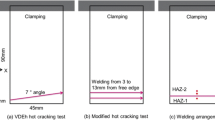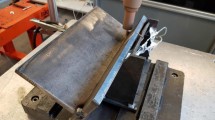Abstract
In this study, a three-dimensional model was developed to investigate the temperature fields during a double-sided laser welding process of T-joints, and the correlations between the thermal characteristics and the mechanical properties were researched in details. To verify the modelling results, welding experiments were conducted with two different welding parameters and the geometrical dimensions of the weld pool were measured. It was found that there was a good agreement between the calculated and the measured results. The calculated results showed that the temperature profile was bilateral symmetry along the stringer centre, and the temperature gradient became greater as running far from the stringer centre, especially on the skin side. All of the tensile specimens were fractured along the fusion line on the skin panels for the head and the hoop tensile tests. The loss of the alloying elements near the fusion line on the skin side resulted in the lowest micro-hardness value appeared here, and made it to be the weakest region of the welded T-joints. The calculated thermal cycles indicated that the materials closest to the fusion line on the skin side had been staying at higher temperature for a longer time, and which is the essential reason for the fracture behaviour, micro-hardness distribution and alloying elements distribution of the double-sided laser welded T-joint.
Similar content being viewed by others
References
Neye G, Heider P (1994) Laser beam welding of modern Al-alloy for the aircraft industry. In: Proc conf ECLAT’94/Dusseldorf: deutscher verband für schweißtechnik, 108–117
Vaidya WV, Horstmann M, Seib E, Toksoy K, Koçak M (2006) Assessment of fracture and fatigue crack propagation of laser beam and friction stir welded aluminium alloys. Adv Eng Mater 8:399–406
Janasekaran S, Jamaludin MF, Muhamad M, Yusof F, Shukor MHA (2016) Autogenous double-sided T-joint welding on aluminum alloys using low power fiber laser. Int J Adv Manuf Technol: 1–9
Brenner B, Stabdfuβ J, Dittrich D, Winderlich B, Liebscher J, Hackius J (2008) Laser beam welding of aircraft fuselage structures. In: Proc ICALEO, Temecula, USA, 838–845
Dittrich D, Standfuss J, Liebscher J, Brenner B, Beyer E (2011) Laser beam welding of hard to weld Al alloys for a regional aircraft fuselage design-first results. Phys Proc 12:113–122
Rao KP, Ramanaiah N, Viswanathan N (2008) Partially melted zone cracking in AA6061 welds. Mater Des 29:179–186
Tan WD, Shin YC (2015) Multi-scale modelling of solidification and microstructure development in laser keyhole welding process for austenitic stainless steel. Comput Mater Sci 98:446–458
Schumacher J, Zerner I, Neye G, Thormann K (2002) Laser beam welding of aircraft fuselage panels. In: Proc ICALEO Section A, Scottsdale, USA
Squillace A, Prisco U (2009) Influence of filler material on mirco- and macro-mechanical behaviour of laser-beam-welded T-joint for aerospace applications. J Mater Des Appl 223:103–115
Yang ZB, Tao W, Li LQ, Chen YB, Li FZ, Zhang YL (2012) Double-sided laser beam welded T-joints for aluminium aircraft fuselage panels: process, microstructure, and mechanical properties. Mater Des 33:652–658
Li X, Wang L, Yang L, Wang J, Li K (2014a) Modelling of temperature field and pool formation during linear laser welding of DP1000 steel. J Mater Process Tech 214:1844–1851
Li XB, Lu FG, Cui HC, Tang XH, Wu YX (2014b) Numerical modeling on the formation process of keyhole-induced porosity for laser welding steel with T-joint. Int J Adv Manuf Technol 72:241–254
Faraji AH, Goodarzi M, Seyedein SH, Barbieri G, Maletta C (2015) Numerical modeling of heat transfer and fluid flow in hybrid laser-TIG welding of aluminum alloy AA6082. Int J Adv Manuf Technol 77:2067–2082
Casalino G, Curcio F, Ludovico AD, Memola Capece Minutolo F (2005) FEM simulation of metal sheets laser welding with wire filler material. In: Proc SPIE, 5958, Lasers and Applications, 59581V
Zain-ul-abdein M, Néliasa D, Jullien JF, Deloison D (2010) Experimental investigation and finite element simulation of laser beam welding induced residual stresses and distortions in thin sheets of AA 6056-T4. Mater Sci Eng A 527:3025–3039
Zhao H, DebRoy T (2003) Macroporosity free aluminium alloy weldments through numerical simulation of keyhole mode laser welding. J Appl Phys 93:10089–10096
Li LJ (1993) Modern laser processing and its equipment. Beijing Institute Technology Press, Beijing, pp 76–77 [In Chinese]
Chakroborty S, Dutta P (2001) A generalized formulation for evaluation of latent heat functions in enthalpy-based macroscopic models for convection-diffusion phase change processes. Metall Mater Trans B Process Metall Mater Process Sci 32:562–564
Faraji A, Goodarzi M, Seyedein S, Zamani M (2014) Experimental study and numerical modeling of arc and weld pool in stationary GTA welding of pure aluminium. Int J Adv Manuf Technol 71:1–13
Li TQ, Wu CS (2015) Numerical simulation of plasma arc welding with keyhole-dependent heat source and arc pressure distribution. Int J Adv Manuf Technol 78:593–602
Fluent user’s guide (2011) ANSYS FLUENT 14.0, Fluent Inc., Pittsburgh pp 743–748
Sohail M, Han SW, Na SJ, Gumenyuk A, Rethmeier M (2015) Numerical investigation of energy input characteristics for high-power fiber laser welding at different positions. Int J Adv Manuf Technol 80:931–946
Youngs DL (1982) Time-dependent multi-material flow with large fluid distortion. Numer Methods Fluid Dyn 24:273–285
Pang S, Chen L, Zhou YY, Chen T (2010) A three-dimensional sharp interface model for self-consistent keyhole and weld pool dynamics in deep penetration laser welding. J Phys D Appl Phys 44:25301–25315
Kang M, Fedkiw RP, Liu XD (2000) A boundary condition capturing method for multiphase incompressible flow. J Sci Comput 15:323–360
Tong AY, Wang Z (2007) A numerical method for capillarity-dominant free surface flows. J Comput Phys 221:506–523
Zain-ul-abdein M, Nélias D, Jullien JF, Boitout F, Dischert L, Noe X (2011) Finite element analysis of metallurgical phase transformations in AA 6056-T4 and their effects upon the residual stress and distortion states of a laser welded T-joint. Int J Pres Ves Pip 88:45–56
Wang RP, Lei YP, Shi YW (2011) Numerical simulation of transient temperature field during laser keyhole welding of 304 stainless steel sheet. Opt Laser Technol 43:870–873
Tao W, Yang ZB, Li LQ, Chen YB, Li FZ, Zhang YL (2013) Double-sided fiber laser beam welding process of T-joints for aluminium aircraft fuselage panels: filler wire melting behaviour, process stability, and their effects on porosity defects. Opt Laser Technol 52:1–9
Syed WUH, Li L (2005) Effects of wire feeding direction and location in multiple layer diode laser direct metal deposition. Appl Surf Sci 248:518–524
Rai R, Elmer JW, Palmer TA, DebRoy T (2007) Heat transfer and fluid flow during keyhole mode laser welding of tantalum, Ti-6Al-4V, 304L stainless steel and vanadium. J Phys D Appl Phys 40:5753–5766
Hu Y, He X, Yu G, Li S, Zheng C, Ning W (2016) Experimental and numerical study on laser keyhole welding of 42CrMo under air and argon atmosphere. Int J Adv Manuf Technol: 1–11
Yang SL, Kovacevic R (2009) Laser welding of galvanized DP980 steel assisted by the GTAW preheating in a gap-free lap joint configuration. J Laser Appl 21:139–148
Braun R (2006) Nd: YAG laser butt welding of AA6013 using silicon and magnesium containing filler powders. Mater Sci Eng A 426:250–262
Author information
Authors and Affiliations
Corresponding author
Rights and permissions
About this article
Cite this article
Yang, Z., Tao, W., Zhao, X. et al. Numerical modelling and experimental verification of thermal characteristics and their correlations with mechanical properties of double-sided laser welded T-joint. Int J Adv Manuf Technol 92, 1609–1618 (2017). https://doi.org/10.1007/s00170-017-0257-6
Received:
Accepted:
Published:
Issue Date:
DOI: https://doi.org/10.1007/s00170-017-0257-6




